-
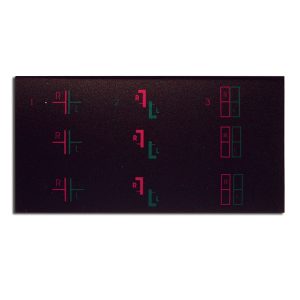
 These offer excellent cancellation with no ghost images. These fixed demand targets provide flat fusion from 1-3 prism diopters, 2nd & 3rd degree fusion from 4-28 PD. BI & BO therapy is possible using a R/G flipper or switching the lenses in the goggles. (Set of 5 cards and one R/G Flipper)
These offer excellent cancellation with no ghost images. These fixed demand targets provide flat fusion from 1-3 prism diopters, 2nd & 3rd degree fusion from 4-28 PD. BI & BO therapy is possible using a R/G flipper or switching the lenses in the goggles. (Set of 5 cards and one R/G Flipper) -

 Black Background Tranaglyphs™ These offer excellent cancellation with no ghost images. These fixed demand targets provide flat fusion from 1-3 prism diopters, 2nd & 3rd degree fusion from 4-28 PD. BI & BO therapy is possible using a R/G flipper or switching the lenses in the goggles. (Set of 5 cards and one R/G Flipper) Size: 10.5" x 5.5"
Black Background Tranaglyphs™ These offer excellent cancellation with no ghost images. These fixed demand targets provide flat fusion from 1-3 prism diopters, 2nd & 3rd degree fusion from 4-28 PD. BI & BO therapy is possible using a R/G flipper or switching the lenses in the goggles. (Set of 5 cards and one R/G Flipper) Size: 10.5" x 5.5" -
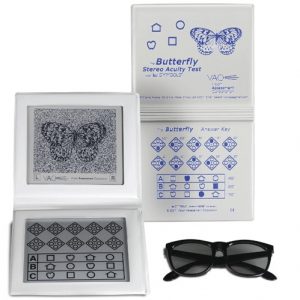 Butterfly Acuity Test with Lea SYMBOLS® Test designed to rapidly test for amblyopia & strabismus using gross thru fine stereopsis (4800 to 20 sec of arc) - Graded Circle Test from 800 sec now down to 20 sec - No monocular clues - New improved booklets - Answer Key on back cover - Includes polarized viewers
Butterfly Acuity Test with Lea SYMBOLS® Test designed to rapidly test for amblyopia & strabismus using gross thru fine stereopsis (4800 to 20 sec of arc) - Graded Circle Test from 800 sec now down to 20 sec - No monocular clues - New improved booklets - Answer Key on back cover - Includes polarized viewers -
 Cardiff Acuity Test Set™ with 36 cards and occluding glasses An upgrade for the Cardiff Acuity Test™ is now offered to meet the differing needs of Pediatric vs. Low Vision patients (Item #: NCATSLVU). The Low Vision upgrade kit includes a set of 3 cards each of levels A, LVB and LVA plus three red dividers. The standard set covers 12 acuity levels from 20/160 to 20/12.5. This version also include a pair of 4608R Butterfly foamy occluding glasses. The Low Vision set covers 14 levels from 20/320 to 20/12.5. There are three cards at each of these acuity levels. Intended for test distances of 1 meter and 50 cm. Cards are laminated and measure 7 3/4 by 10 1/2 in (20 by 27 cm) and are labeled by acuity level equivalents in decimal, meters, feet, Snellen and LogMAR for both test distances.
Cardiff Acuity Test Set™ with 36 cards and occluding glasses An upgrade for the Cardiff Acuity Test™ is now offered to meet the differing needs of Pediatric vs. Low Vision patients (Item #: NCATSLVU). The Low Vision upgrade kit includes a set of 3 cards each of levels A, LVB and LVA plus three red dividers. The standard set covers 12 acuity levels from 20/160 to 20/12.5. This version also include a pair of 4608R Butterfly foamy occluding glasses. The Low Vision set covers 14 levels from 20/320 to 20/12.5. There are three cards at each of these acuity levels. Intended for test distances of 1 meter and 50 cm. Cards are laminated and measure 7 3/4 by 10 1/2 in (20 by 27 cm) and are labeled by acuity level equivalents in decimal, meters, feet, Snellen and LogMAR for both test distances. -
 Projector Slide Replacements Child Acuity Projector Slide Allen Figures, Tumbling "E", Landolt "C" This family of projector slides are designed for testing all ages. Made of high quality photographic film, sealed between two pieces of glass to ensure sharp optotypes to maintain the integrity of your exam. Each slide must be adjusted for use on different length testing lanes.
Projector Slide Replacements Child Acuity Projector Slide Allen Figures, Tumbling "E", Landolt "C" This family of projector slides are designed for testing all ages. Made of high quality photographic film, sealed between two pieces of glass to ensure sharp optotypes to maintain the integrity of your exam. Each slide must be adjusted for use on different length testing lanes. -
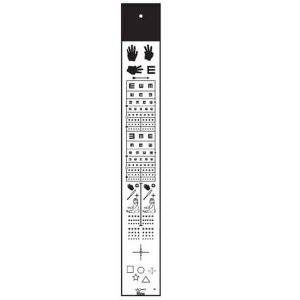 Child Vectorgraphic Projector Slide → Training Demonstration → Tumbling E Monocular 20/100 – 20/15 (9 Lines) → Acuity Balance 20/30 – 20/20 (3 Lines) → Tumbling E Binocular 20/30 – 20/15 (4 Lines) → Fixation Disparity with Fusion Lock → Stereopsis 215 - 40 seconds of arc
Child Vectorgraphic Projector Slide → Training Demonstration → Tumbling E Monocular 20/100 – 20/15 (9 Lines) → Acuity Balance 20/30 – 20/20 (3 Lines) → Tumbling E Binocular 20/30 – 20/15 (4 Lines) → Fixation Disparity with Fusion Lock → Stereopsis 215 - 40 seconds of arc -
 Yoked Empty Rotating Prisms (VTE) Plastic frame with nasal anatomical fit for children. Blue and Red Colors Item #: E/FRRYPC
Yoked Empty Rotating Prisms (VTE) Plastic frame with nasal anatomical fit for children. Blue and Red Colors Item #: E/FRRYPC -

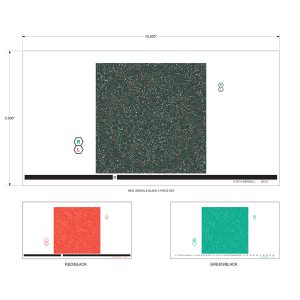 The new Random Dot 3D Clock Variable Tranaglyph is an excellent new training device for both the mid-level and final stages of base-in and base-out therapy. Unlike the typical 3D training images, random dot images can not be seen unless the highest level of fusion is achieved. The images simply look like a page full of dots, until the two eyes and brain combine these two sets of unique images into a single three dimensional image. This makes it an excellent therapy technique for those patients who are simply guessing or malingering with traditional cards sets. The level of fusion needed is the most difficult to obtain and requires the highest level of visual processing, which makes it an excellent finalization exercise. For patients who have had limited binocular vision, such as the recently corrected amblyopic or strabismic patient, this task may prove to be too difficult. For those patients, you may need to start with a 500 series tranaglyph, then progress to the 600 series and finalize with the Random dot series. Item #: BC12+
The new Random Dot 3D Clock Variable Tranaglyph is an excellent new training device for both the mid-level and final stages of base-in and base-out therapy. Unlike the typical 3D training images, random dot images can not be seen unless the highest level of fusion is achieved. The images simply look like a page full of dots, until the two eyes and brain combine these two sets of unique images into a single three dimensional image. This makes it an excellent therapy technique for those patients who are simply guessing or malingering with traditional cards sets. The level of fusion needed is the most difficult to obtain and requires the highest level of visual processing, which makes it an excellent finalization exercise. For patients who have had limited binocular vision, such as the recently corrected amblyopic or strabismic patient, this task may prove to be too difficult. For those patients, you may need to start with a 500 series tranaglyph, then progress to the 600 series and finalize with the Random dot series. Item #: BC12+ -
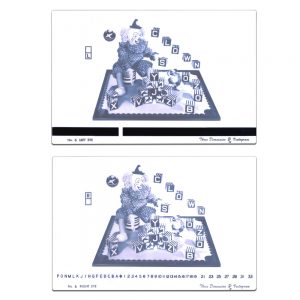 Variable Vectogram Clown Vectogram 8-1/4" x 5-1/2" Polarized vectograms ensure testing and training at actual distances. Vectograms stabilize fusion and steropsis, eliminate suppression and develop simultaneous vision. Used in monocular, binocular pursuit and saccadic training, vectograms help correct and prevent anomalies involving projection and hand-eye coordination. Ideal for use with Bernell's Dual Polachrome™ Trainer
Variable Vectogram Clown Vectogram 8-1/4" x 5-1/2" Polarized vectograms ensure testing and training at actual distances. Vectograms stabilize fusion and steropsis, eliminate suppression and develop simultaneous vision. Used in monocular, binocular pursuit and saccadic training, vectograms help correct and prevent anomalies involving projection and hand-eye coordination. Ideal for use with Bernell's Dual Polachrome™ Trainer -
 Same great test, but in a new and improved package! The ColorDx Pediatric 15 is the newest version of Color Vision Testing Made Easy or CVTME. As the Gold Standard pediatric assessment of color deficiencies or color blindness See The Multi-Ethnic Pediatric Eye Disease Study published by the AAO, CVTME™ is used in over 40 countries and has been validated for illiterates at the US Special Olympics. Featuring the proven Waggoner six confusion-color strategy, the pediatric test is used in a broad range of settings: pediatrics, eye physicians, school nurses, and many other disciplines of health care, in any language, world-wide. This easy to administer test features both hidden and non-hidden shapes that allow for positive reinforcement even while testing color deficient children by allowing successful answers on most targets. This success-reinforced strategy is also useful for assessment of malingering. Designed by color vision expert Dr. Terrace Waggoner, this new edition features enhanced digital colorimetery production methods, durable page and binding materials, and magnetic light-protective storage case and enhanced digital colorimetery production method and durable page materials and binding. Brilliantly simple to take, easy to score and just plain fun for children.
Same great test, but in a new and improved package! The ColorDx Pediatric 15 is the newest version of Color Vision Testing Made Easy or CVTME. As the Gold Standard pediatric assessment of color deficiencies or color blindness See The Multi-Ethnic Pediatric Eye Disease Study published by the AAO, CVTME™ is used in over 40 countries and has been validated for illiterates at the US Special Olympics. Featuring the proven Waggoner six confusion-color strategy, the pediatric test is used in a broad range of settings: pediatrics, eye physicians, school nurses, and many other disciplines of health care, in any language, world-wide. This easy to administer test features both hidden and non-hidden shapes that allow for positive reinforcement even while testing color deficient children by allowing successful answers on most targets. This success-reinforced strategy is also useful for assessment of malingering. Designed by color vision expert Dr. Terrace Waggoner, this new edition features enhanced digital colorimetery production methods, durable page and binding materials, and magnetic light-protective storage case and enhanced digital colorimetery production method and durable page materials and binding. Brilliantly simple to take, easy to score and just plain fun for children. -
 Same great test as before, but with a new and improved package! One of only two color vision tests validated and required for Naval Aviators. ColorDx is new brand identity for the proven Waggoner six confusion-color strategy used by physicians, Ophthalmologists, Optometrists, and nurses worldwide. This military grade test is used by the US Army and for FAA annual flight physicals requiring color vision testing and has been independently validated by both academic institutions and military services. This new edition features enhanced digital colorimetery production methods, durable page and binding materials, and magnetic light-protective storage case. The ColorDx Standard 24 is designed and licensed from color vision expert Dr. Terrace Waggoner and is the newest edition of the Waggoner PIP-24 (PIPIC 24).
Same great test as before, but with a new and improved package! One of only two color vision tests validated and required for Naval Aviators. ColorDx is new brand identity for the proven Waggoner six confusion-color strategy used by physicians, Ophthalmologists, Optometrists, and nurses worldwide. This military grade test is used by the US Army and for FAA annual flight physicals requiring color vision testing and has been independently validated by both academic institutions and military services. This new edition features enhanced digital colorimetery production methods, durable page and binding materials, and magnetic light-protective storage case. The ColorDx Standard 24 is designed and licensed from color vision expert Dr. Terrace Waggoner and is the newest edition of the Waggoner PIP-24 (PIPIC 24). -
 Basic prism set in handsome wood case, foam-lined for protection. Item #: APS30+
Basic prism set in handsome wood case, foam-lined for protection. Item #: APS30+ -
 Combined D-15 Test Similar test to the Anthony and Farnsworth. Box contains 16 caps with different colored papers attached. The unique feature is that the box is designed to shorten test time. When raised, the caps can easily slide out one end that raises with the top. Then, the patient inserts the caps, the box is closed, and the box turned over revealing a clear bottom through which to score the selections. Item #: G15130
Combined D-15 Test Similar test to the Anthony and Farnsworth. Box contains 16 caps with different colored papers attached. The unique feature is that the box is designed to shorten test time. When raised, the caps can easily slide out one end that raises with the top. Then, the patient inserts the caps, the box is closed, and the box turned over revealing a clear bottom through which to score the selections. Item #: G15130 -
 Set Includes Vertical prism bar with the following powers: 1,2,3,4,5,6,8,10,12,14,16,18,20,25 & 30 Horizontal prism bar with the following powers: 1,2,4,6,8,10,12,14,16,18,20,25,30,35,40 & 45 Item #: ACPS31
Set Includes Vertical prism bar with the following powers: 1,2,3,4,5,6,8,10,12,14,16,18,20,25 & 30 Horizontal prism bar with the following powers: 1,2,4,6,8,10,12,14,16,18,20,25,30,35,40 & 45 Item #: ACPS31 -
 CRT Card Test Specifically designed for computer operators who require corrective multi-focal eyewear. Card may be placed at different heights and distanced to simulate the complete computer screen. Card is printed two sides -one side shows a computer screen with AOL. The other (Pictured) shows a Microsoft Word document with different fonts. Simulates a 15" computer monitor with shiny screen. has intentional errors to show red/green highlights.
CRT Card Test Specifically designed for computer operators who require corrective multi-focal eyewear. Card may be placed at different heights and distanced to simulate the complete computer screen. Card is printed two sides -one side shows a computer screen with AOL. The other (Pictured) shows a Microsoft Word document with different fonts. Simulates a 15" computer monitor with shiny screen. has intentional errors to show red/green highlights. -
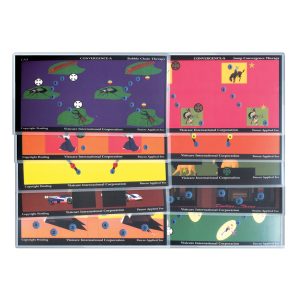 Morgenstern Color Fusion Cards - Convergence A Dr. Only Used with Bernell-O-Scope™ CONVERGENCE A. TRADITIONAL VT FOR FUSION RANGES & JUMP DUCTIONS WITH COLORFUL TARGETS. INCREASE IN DEMAND AND RANGE OF FLEXIBILITY. Item #: SMCA
Morgenstern Color Fusion Cards - Convergence A Dr. Only Used with Bernell-O-Scope™ CONVERGENCE A. TRADITIONAL VT FOR FUSION RANGES & JUMP DUCTIONS WITH COLORFUL TARGETS. INCREASE IN DEMAND AND RANGE OF FLEXIBILITY. Item #: SMCA -
 Morgenstern Color Fusion Cards - Convergence B DR ONLY USED WITH BERNELL-O-SCOPE™ BUILD LARGER RANGES OF VERGENCE. WORK IN AND OUT OF INSTRUMENT. GOOD FOR "TROMBONING" IN STEROSCOPE AS WELL AS "POINTING". SET OF 10 CARDS Item #: SMCB
Morgenstern Color Fusion Cards - Convergence B DR ONLY USED WITH BERNELL-O-SCOPE™ BUILD LARGER RANGES OF VERGENCE. WORK IN AND OUT OF INSTRUMENT. GOOD FOR "TROMBONING" IN STEROSCOPE AS WELL AS "POINTING". SET OF 10 CARDS Item #: SMCB -
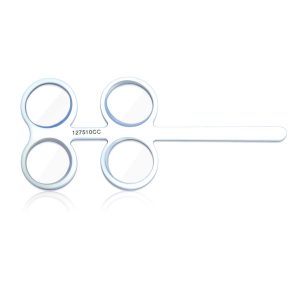
 Flat prisms or Corrected Curved Prisms Professional training with two yoked prism pairs. Beginning with the highest powers through which a patient can fuse and focus, prism flippers are exchanged for the next higher powers through the training sequence. Great for early presbyopes with high exo with new bifocals! Please specify diopter power when ordering and if flat prism or corrected for abberations and made as thin as possible (corrected curved). Available in sizes 1D - 10D Item #: BC1275+
Flat prisms or Corrected Curved Prisms Professional training with two yoked prism pairs. Beginning with the highest powers through which a patient can fuse and focus, prism flippers are exchanged for the next higher powers through the training sequence. Great for early presbyopes with high exo with new bifocals! Please specify diopter power when ordering and if flat prism or corrected for abberations and made as thin as possible (corrected curved). Available in sizes 1D - 10D Item #: BC1275+ -
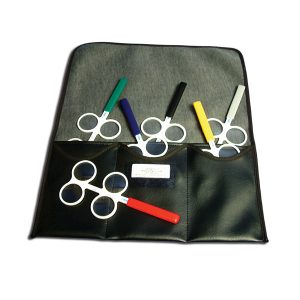 Six-piece set includes: 2D,3D,4D,5D,6D and 8D flippers. Professional training with two prism pairs. Beginning with the highest powers through which a patient can fuse and focus, prism flippers are exchanged for next higher powers through the training sequence. GREAT FOR BEGINNING PRESBYOPES WHO HAVE EXO WITH THEIR BIFOCALS! All flippers have corrected curve lenses and come in a deluxe black carrying case. Save money with this kit! Note: Prism diopter powers are listed per lens. For example, a 4PD flipper will have two 4PD lenses to make a 8PD range. So, 4PD flipper = 8PD range. Item #: BC1275SETCC
Six-piece set includes: 2D,3D,4D,5D,6D and 8D flippers. Professional training with two prism pairs. Beginning with the highest powers through which a patient can fuse and focus, prism flippers are exchanged for next higher powers through the training sequence. GREAT FOR BEGINNING PRESBYOPES WHO HAVE EXO WITH THEIR BIFOCALS! All flippers have corrected curve lenses and come in a deluxe black carrying case. Save money with this kit! Note: Prism diopter powers are listed per lens. For example, a 4PD flipper will have two 4PD lenses to make a 8PD range. So, 4PD flipper = 8PD range. Item #: BC1275SETCC -

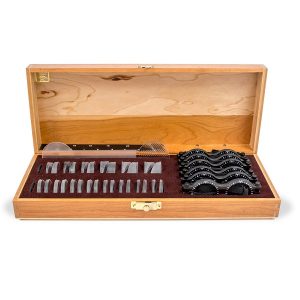 Deluxe Kit has (28) prisms, (6) frames, & Maddox Rod in a wooden case with pre-cut foam to keep prisms safe & clean. Note: Prism diopter powers are listed per lens. For example, a 4PD goggle will have two 4PD lenses to make a 8PD range. So, 4PD goggle = 8PD range. Item #: 1138KIT28+
Deluxe Kit has (28) prisms, (6) frames, & Maddox Rod in a wooden case with pre-cut foam to keep prisms safe & clean. Note: Prism diopter powers are listed per lens. For example, a 4PD goggle will have two 4PD lenses to make a 8PD range. So, 4PD goggle = 8PD range. Item #: 1138KIT28+ -
 Look more modern while improving your accuracy and decreasing remakes with your PAL's. This digital pupilometer is easy to use. Requires 4 AA batteries (not included).
Look more modern while improving your accuracy and decreasing remakes with your PAL's. This digital pupilometer is easy to use. Requires 4 AA batteries (not included). -
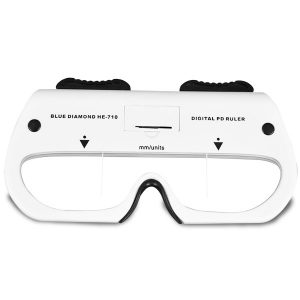
 The Direct Digital Pupil Gauge is a simple and inexpensive way to measure both monocular and binocular distances between eyes. This is necessary for accurate fitting of various ophthalmic lenses, especially multi-focals. It works by simply aligning the vertical stripes over the center of each pupillary reflex.
The Direct Digital Pupil Gauge is a simple and inexpensive way to measure both monocular and binocular distances between eyes. This is necessary for accurate fitting of various ophthalmic lenses, especially multi-focals. It works by simply aligning the vertical stripes over the center of each pupillary reflex. -
DISTANCE ACUITY GUIDE FOR PROJECTOR SLIDES Target size guide from 7.5ft to 26ft in 0.5ft steps, ranges up to 30ft.
-
 Morgenstern Color Fusion Cards - Divergence A USED WITH BERNELL-O-SCOPE™ DIVERGENCE A CARDS. TRADITIONAL VT FOR FUSION RANGES & JUMP DUCTIONS WITH COLORFUL TARGETS. INCREASE IN DEMAND AND RANGE OF FLEXIBILITY. Item #: SMDA
Morgenstern Color Fusion Cards - Divergence A USED WITH BERNELL-O-SCOPE™ DIVERGENCE A CARDS. TRADITIONAL VT FOR FUSION RANGES & JUMP DUCTIONS WITH COLORFUL TARGETS. INCREASE IN DEMAND AND RANGE OF FLEXIBILITY. Item #: SMDA -
 Morgenstern Color Fusion Cards - Divergence B Used with Bernell-O-Scope™ Builds large ranges of vergence (pull all the way in and out). Work in and out of instrument. Hold in space and fuse, diverge, move fused targets and also converge some. Made for "tromboning" work in the stereoscope as well as "pointing". Each card features eclectic designs and unique arrangements. Item #: SMDB
Morgenstern Color Fusion Cards - Divergence B Used with Bernell-O-Scope™ Builds large ranges of vergence (pull all the way in and out). Work in and out of instrument. Hold in space and fuse, diverge, move fused targets and also converge some. Made for "tromboning" work in the stereoscope as well as "pointing". Each card features eclectic designs and unique arrangements. Item #: SMDB -
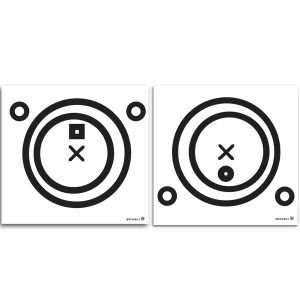
 Free space fusion performed in a new, inexpensive way. Black target circles are printed on two 6" x 7" clear acetate cards. A unique, accurate method of developing increased fusional range without the need for costly lenses or filters.
Free space fusion performed in a new, inexpensive way. Black target circles are printed on two 6" x 7" clear acetate cards. A unique, accurate method of developing increased fusional range without the need for costly lenses or filters. -

 The new clear fixation paddle is 12" x 12" made of clear polycarbonate. Uses targets with cling material which adheres and removes easily from the front or back of the paddles by adhesion forces.
The new clear fixation paddle is 12" x 12" made of clear polycarbonate. Uses targets with cling material which adheres and removes easily from the front or back of the paddles by adhesion forces. -
 Adult LEA NUMBERS® chart for ETDRS Illuminated light boxes. Fits all existing ETDRS cabinets including both the ESV3000 and ESC2000. LEA NUMBERS® ETDRS chart contains optotypes in proportionally spaced (logMAR) lines; lines range from 20/200 to 20/8 (6/60 to 6/2.4) equivalent, 0.10 to 2.50. Fits in ESV3000 ETDRS illuminated cabinet.
Adult LEA NUMBERS® chart for ETDRS Illuminated light boxes. Fits all existing ETDRS cabinets including both the ESV3000 and ESC2000. LEA NUMBERS® ETDRS chart contains optotypes in proportionally spaced (logMAR) lines; lines range from 20/200 to 20/8 (6/60 to 6/2.4) equivalent, 0.10 to 2.50. Fits in ESV3000 ETDRS illuminated cabinet. -
 The ESC2000 Illuminator Cabinet provides a uniform retro-illuminated testing surface, ideal for clinical testing of high contrast and low contrast LogMAR tests, including ETDRS, Lea Symbols, Lea Numbers, Landolt C, etc. The cabinet utilizes a pure-white LED light source. (Stand not included. Can be purchased separately. Part # GL50004)
The ESC2000 Illuminator Cabinet provides a uniform retro-illuminated testing surface, ideal for clinical testing of high contrast and low contrast LogMAR tests, including ETDRS, Lea Symbols, Lea Numbers, Landolt C, etc. The cabinet utilizes a pure-white LED light source. (Stand not included. Can be purchased separately. Part # GL50004) -

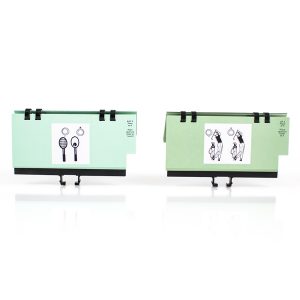 Extra Aperture Rule™ Cards Select either Bernstein Bears for pediatric use or Sports/Action targets. Techniques and target designs are developed for children and adult motivation.
Extra Aperture Rule™ Cards Select either Bernstein Bears for pediatric use or Sports/Action targets. Techniques and target designs are developed for children and adult motivation. -
 Designed for use in manual Chart Projectors including products from: R.H. Burton, Marco, Reichart, Topcon, and Woodlyn. Includes test for: → Tumbling E 20/400 – 20/200 (3 Lines) → Sloan Letters 20/100 – 20/10 (11 Lines) → Astigmatic Clock → Sloan Letters 20/50 – 20/10 (6 Lines) → Tumbling E 20/50 – 20/15 (5 Lines) → Allen Acuity 20/100 – 20/40 (4 Lines) Item #: VA1193
Designed for use in manual Chart Projectors including products from: R.H. Burton, Marco, Reichart, Topcon, and Woodlyn. Includes test for: → Tumbling E 20/400 – 20/200 (3 Lines) → Sloan Letters 20/100 – 20/10 (11 Lines) → Astigmatic Clock → Sloan Letters 20/50 – 20/10 (6 Lines) → Tumbling E 20/50 – 20/15 (5 Lines) → Allen Acuity 20/100 – 20/40 (4 Lines) Item #: VA1193 -
 Projector Slide Replacements Family Practice Slide Letter Acuity, Astigmatic Clock, Tumbling "E", Allen Figures This family of projector slides are designed for testing all ages. Made of high quality photographic film, sealed between two pieces of glass to ensure sharp optotypes to maintain the integrity of your exam. Each slide must be adjusted for use on different length testing lanes.
Projector Slide Replacements Family Practice Slide Letter Acuity, Astigmatic Clock, Tumbling "E", Allen Figures This family of projector slides are designed for testing all ages. Made of high quality photographic film, sealed between two pieces of glass to ensure sharp optotypes to maintain the integrity of your exam. Each slide must be adjusted for use on different length testing lanes. -
 Gem Polarized Variable Vectographic with Fixation Disparity Target → Stereopsis depth of 700 seconds of arc → Includes Fixation Disparity target with central Fusion Lock → 16 diopter range for Base-In (Divergence) Training → 24 diopter range for Base-Out (Convergence) Training → Total accommodation range of 40 diopters → New improved Vecto Guides → Now includes Therapy Binder → Now includes doctor and patient instruction manuals → Now includes Patient Vision Therapy Record Form → Includes Standard Polarized Viewers Item #: VA1060PL
Gem Polarized Variable Vectographic with Fixation Disparity Target → Stereopsis depth of 700 seconds of arc → Includes Fixation Disparity target with central Fusion Lock → 16 diopter range for Base-In (Divergence) Training → 24 diopter range for Base-Out (Convergence) Training → Total accommodation range of 40 diopters → New improved Vecto Guides → Now includes Therapy Binder → Now includes doctor and patient instruction manuals → Now includes Patient Vision Therapy Record Form → Includes Standard Polarized Viewers Item #: VA1060PL -
 This handheld circular pupillometer device is used for measuring different size pupils. It was developed and researched by Dr. Jack Richman, O.D., as part of the Massachusetts Drug Evaluation and Classification Program (MDEP). This pupil measurement device is used by law enforcement officers across the country to assist in determining whether people are possibly impaired and/or under the influence of drugs. The reverse side has expected pupil size in different lighting conditions for non-impaired people. Item #: LV3553000
This handheld circular pupillometer device is used for measuring different size pupils. It was developed and researched by Dr. Jack Richman, O.D., as part of the Massachusetts Drug Evaluation and Classification Program (MDEP). This pupil measurement device is used by law enforcement officers across the country to assist in determining whether people are possibly impaired and/or under the influence of drugs. The reverse side has expected pupil size in different lighting conditions for non-impaired people. Item #: LV3553000 -
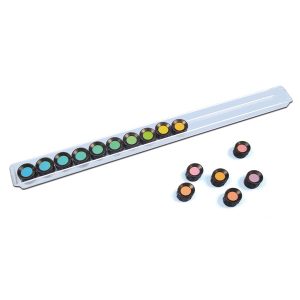 Farnsworth D15 Dichotomous Color Test Farnsworth Test for Congenital and Acquired color defects. The Farnsworth D-15 contains a reference disc holding notation 10 B 5 4 and fifteen numbered discs which make up an incomplete color circle. The patient arranges the discs and then evaluation of the patients arrangement separates 'normal' color perception from moderate and strong defects in deutan, protan or tritan axis color discrimination. The D-15 is housed in a plexiglass container. the disks are spread out on a table and arranged by the patient. The Farnsworth D-15 test is a subset of the well known Farnsworth 100 Hue Test. It is intended for classification instead of in-depth study of color vision defects. The D-15 and 100 hue tests are correlated. Growing Importance of Color deficiency Screening. In addition to congenital color deficiency screening there is growing evidence that adult acquired color deficiency, especially in yellow and blue perception, can indicate medical toxicity and other problems. Increasingly complex security and medical systems also require verification of all three types of color receptors. How the D-15 test works: The Farnsworth D15 is called 'dichotomous' because it is designed to separate subjects into one of two groups, 1) Strongly color deficient or 2) Mildly color deficient or color normal. This is accomplished by the arrangement of vivid (saturated) colored discs. A perfect score shows normal color perception. A non-perfect score is used to determine a medium or strong color deficiency.
Farnsworth D15 Dichotomous Color Test Farnsworth Test for Congenital and Acquired color defects. The Farnsworth D-15 contains a reference disc holding notation 10 B 5 4 and fifteen numbered discs which make up an incomplete color circle. The patient arranges the discs and then evaluation of the patients arrangement separates 'normal' color perception from moderate and strong defects in deutan, protan or tritan axis color discrimination. The D-15 is housed in a plexiglass container. the disks are spread out on a table and arranged by the patient. The Farnsworth D-15 test is a subset of the well known Farnsworth 100 Hue Test. It is intended for classification instead of in-depth study of color vision defects. The D-15 and 100 hue tests are correlated. Growing Importance of Color deficiency Screening. In addition to congenital color deficiency screening there is growing evidence that adult acquired color deficiency, especially in yellow and blue perception, can indicate medical toxicity and other problems. Increasingly complex security and medical systems also require verification of all three types of color receptors. How the D-15 test works: The Farnsworth D15 is called 'dichotomous' because it is designed to separate subjects into one of two groups, 1) Strongly color deficient or 2) Mildly color deficient or color normal. This is accomplished by the arrangement of vivid (saturated) colored discs. A perfect score shows normal color perception. A non-perfect score is used to determine a medium or strong color deficiency. -
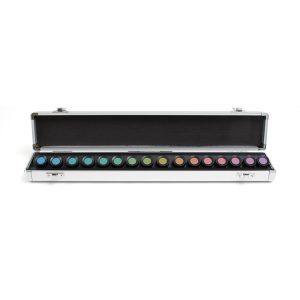 Farnsworth Test for Congenital and Acquired color defects. The Farnsworth D-15 contains a reference disc holding notation 10 B 5 4 and fifteen numbered discs which make up an incomplete color circle. The patient arranges the discs and then evaluation of the patients arrangement separates 'normal' color perception from moderate and strong defects in deutan, protan or tritan axis color discrimination. The disks are spread out on a table and arranged by the patient. The Farnsworth D-15 test is a subset of the well known Farnsworth 100 Hue Test. It is intended for classification instead of in-depth study of color vision defects. The D-15 and 100 hue tests are correlated. Growing Importance of Color deficiency Screening: In addition to congenital color deficiency screening there is growing evidence that adult acquired color deficiency, especially in yellow and blue perception, can indicate medical toxicity and other problems. Increasingly complex security and medical systems also require verification of all three types of color receptors. How the D-15 test works: The Farnsworth D15 is called 'dichotomous' because it is designed to separate subjects into one of two groups, 1) Strongly color deficient or 2) Mildly color deficient or color normal. This is accomplished by the arrangement of vivid (saturated) colored discs. A perfect score shows normal color perception. A non-perfect score is used to determine a medium or strong color deficiency.
Farnsworth Test for Congenital and Acquired color defects. The Farnsworth D-15 contains a reference disc holding notation 10 B 5 4 and fifteen numbered discs which make up an incomplete color circle. The patient arranges the discs and then evaluation of the patients arrangement separates 'normal' color perception from moderate and strong defects in deutan, protan or tritan axis color discrimination. The disks are spread out on a table and arranged by the patient. The Farnsworth D-15 test is a subset of the well known Farnsworth 100 Hue Test. It is intended for classification instead of in-depth study of color vision defects. The D-15 and 100 hue tests are correlated. Growing Importance of Color deficiency Screening: In addition to congenital color deficiency screening there is growing evidence that adult acquired color deficiency, especially in yellow and blue perception, can indicate medical toxicity and other problems. Increasingly complex security and medical systems also require verification of all three types of color receptors. How the D-15 test works: The Farnsworth D15 is called 'dichotomous' because it is designed to separate subjects into one of two groups, 1) Strongly color deficient or 2) Mildly color deficient or color normal. This is accomplished by the arrangement of vivid (saturated) colored discs. A perfect score shows normal color perception. A non-perfect score is used to determine a medium or strong color deficiency.



